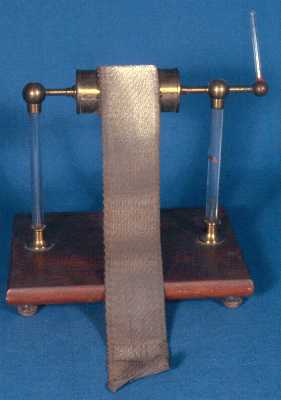
|
Q = CV
"The distribution of electricity on the surface may
also be shown by means of the following apparatus: -- It consists of a
metal cylinder on insulated supports, on which is fixed a long strip of
tin-foil which can be rolled up by means of a small insulating handle.
A quadrant electrometer is fitted in metallic communication with the cylinder.
When the [tin-foil] is rolled up, a charge is imparted to the cylinder, by
which a certain divergence is produced. On unrolling the tin-foil this divergence
gradually diminishes, and increases at it is again rolled up. The quantity
of electricity remains the same, the electrical force, on each unit of sufrace,
is therefore less as the surface is greater."
(From Ganot's Physics, 1883 edition, pp 654-655)
In short, C depends on the area of the capacitor that
is charged with a constant charge Q. When C increases, V decreases.
Return
to Electricity Home Page | Return
to Home Page
|